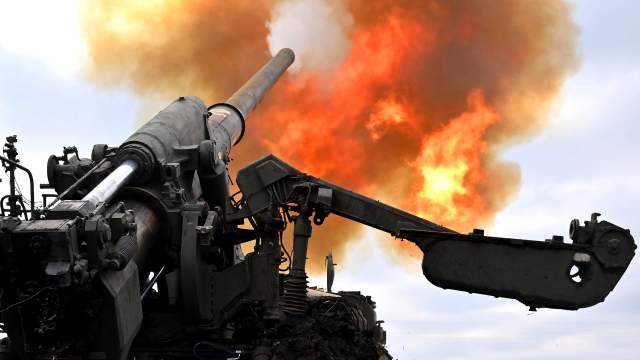"Peonies", "Malki" and "Tulips" will become more effective as part of new brigades and in coordination with UAVs
New high-capacity artillery brigades are being created in the Russian troops. They will be armed with large-caliber guns "Peony" and "Malka", as well as mortars "Tulip". The brigades will also include units of unmanned aircraft for effective guidance and fire correction. Izvestia investigated what capabilities 2C7 family guns have in modern armed conflicts, how much more effective automated control systems, new precision-guided munitions and interaction with UAVs will make them.
Large caliber
The first high-capacity artillery brigade has already been formed as part of the 3rd Zaporozhye Army Corps. Their creation is a direct consequence of the experience of a special military operation. The transition to a new tactic of attacks on the immediate rear and fortified areas of the enemy indicates a rethinking of the role of artillery systems in modern warfare. The use of reconnaissance and strike complexes with unmanned reconnaissance vehicles has shown that high-power artillery today is one of the most effective fire means of both counter—battery warfare and the destruction of well-fortified enemy defense areas. And our country is one of the few where such systems have been created.
The basis of the new brigades will be the most powerful artillery systems of the Armed Forces of the Russian Federation to date — self-propelled installations 2S7 "Peony" and 2S7M "Malka" with 203 mm guns. Heavy 2C4 "Tulip" mortars with a record caliber of 240 mm will break into fortified areas.
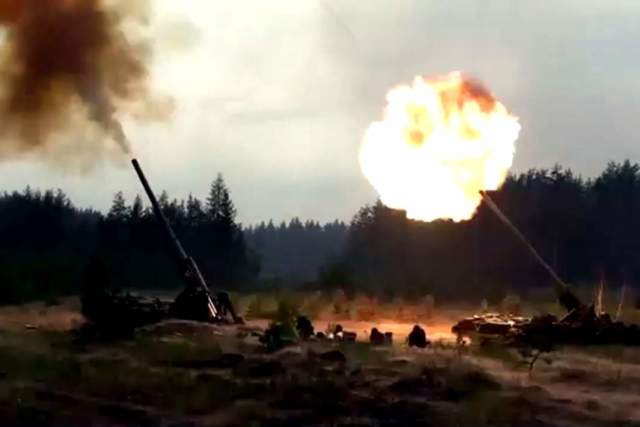
Self-propelled artillery units (ACS) 2S7M "Malka"
Image source: Photo: RIA Novosti/Ministry of Defense of the Russian Federation
The USSR began to create artillery systems of special power in the 1950s. It was assumed that they would fire at enemy positions with projectiles with a nuclear warhead. For the new monstrous guns, a caliber of 406 mm was chosen, since the technologies of that time did not allow a nuclear charge to fit into a smaller caliber. In 1955, the development of the 2B1 "Oka" self-propelled mortar and the 2A3 "Condenser" self-propelled gun began. Unique tracked chassis were created at the Kirov Plant in Leningrad, and on November 7, 1957, the SAU 2A3 was paraded in Moscow, which became a real sensation for Western military observers.
But in those years, such powerful artillery systems turned out to be very complex and expensive. And the appearance and rapid development of tactical and operational-tactical missiles provided the ground forces with a "nuclear baton" with a range of 25 to 70 km, and in the future, with the advent of 9K72 complexes — up to 300 kilometers. In addition, Nikita Khrushchev was an opponent of artillery and a great connoisseur of missiles.
In the late 1960s, the development of tank troops and artillery, as well as the miniaturization of nuclear charges, made it possible to create powerful artillery systems with acceptable dimensions. In 1967, on the instructions of the Main Rocket and Artillery Directorate of the Soviet Army, research began on the appearance of promising artillery systems for the reserve of the Supreme High Command (RVGK). They had to solve special tasks of fire support for the breakthroughs of Soviet tank wedges through the dense NATO defenses in the European theater of operations.
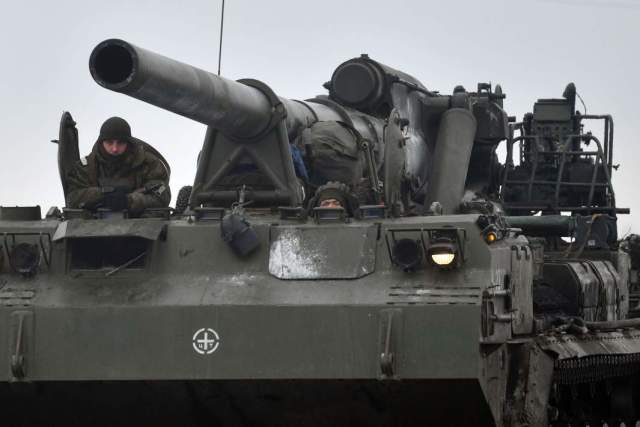
Self-propelled artillery installation (ACS) 2C7 "Peony"
Image source: Photo: RIA Novosti/Mikhail Voskresensky
Several variants of guns of caliber from 180 to 210 mm were considered. And as a result, the 2A44 203 mm caliber gun was chosen by chief designer Grigory Alekseev. With this gun, a new self-propelled artillery installation (ACS) 2C7 "Peony" was created. In 1973, the requirements were approved for it: a ricochet-free firing range from 8.5 to 35 km with a high-explosive shell weighing 110 kg, the ability to fire a 3BB2 nuclear shot designed for a 203 mm B-4M howitzer, independent movement at speeds up to 50 km/ h on highways and rough terrain.
The Peony was adopted in 1975. Two years later, the All-Union Research Institute of Technical Physics developed the latest nuclear munitions installations.
As is often the case, following the adoption of a revolutionary combat system, work immediately began on its modernization. As a result, in 1986, serial production of the modernized 2S7M Malka self—propelled gun was started. The most modern equipment for that time appeared on it — digital indicators for displaying information with automatic data reception. That is, information could be sent from the senior officer's car to all battery installations — directly to the workplaces of gunners and plant commanders.
This significantly accelerated the deployment of combat vehicles to prepare for the strike. Thanks to the new mechanism, the installation could be loaded at any angle of vertical guidance of the gun. Due to this, the rate of fire of the gun increased from 1.5 to 2.5 rounds per minute. It was the most powerful Soviet self-propelled gun. In total, more than 500 units of the 2C7 and 2C7M self-propelled guns were produced.
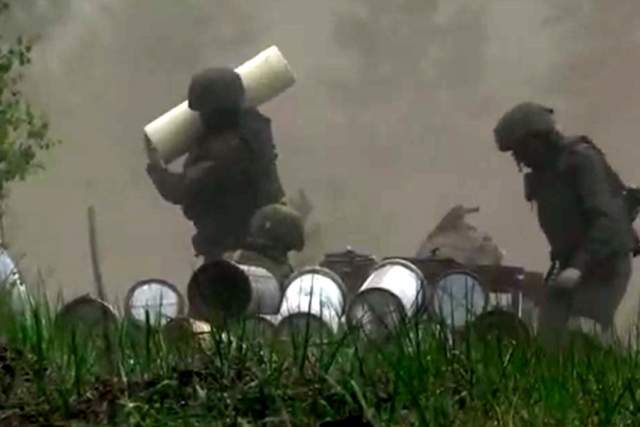
Photo: RIA Novosti/Ministry of Defense of the Russian Federation
Image source: iz.ru
New features
At the end of 1967, almost simultaneously with the "Peony", work began on the creation of a self-propelled large-caliber mortar 2C4 "Tulip". His task was to destroy heavily defended fortified areas with coordinated group use.
The caliber of the new mortar was 240 mm, and the ammunition included 53F864 high-explosive mines with a firing range of 9.65 km, as well as 3F2 active-rocket mines with a maximum firing range of 19.69 km. In the 1980s, the Daredevil adjustable mine, nuclear ammunition with a capacity of several kilotons and neutron mines "Resin" and "Fata" were created for the mortar. Since 1972, "Tulips" began to be supplied to the artillery units of the RVGK.
Today, all these artillery samples have received modern digital systems for obtaining information about the coordinates of targets, as well as satellite positioning systems on the ground. Thus, with the development of unmanned reconnaissance aircraft, the prerequisites have developed for the second life of high-power artillery as part of the corresponding artillery brigades.
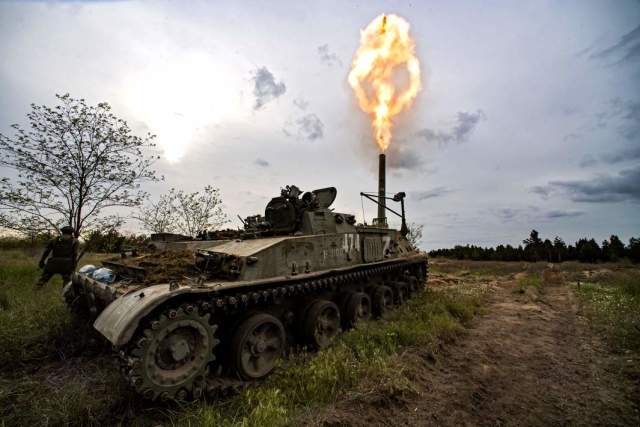
Self-propelled large-caliber mortar 2C4 "Tulip"
Image source: Photo: RIA Novosti/Dmitry Makeev
Equipped with their own fleet of reconnaissance drones, from which information is sent directly to the command and staff vehicles of artillery batteries, self-propelled gunners are able to instantly transfer fire to the most important and dangerous targets at the moment. This ensures the high efficiency of the use of artillery both in defense and in conducting offensive operations.
And, of course, mobility, which is initially possessed by high-power self-propelled artillery units, is extremely important for the offensive. Even in non-nuclear equipment, they are deadly and give the command a magnificent and highly accurate large-caliber fist.
Dmitry Kornev
